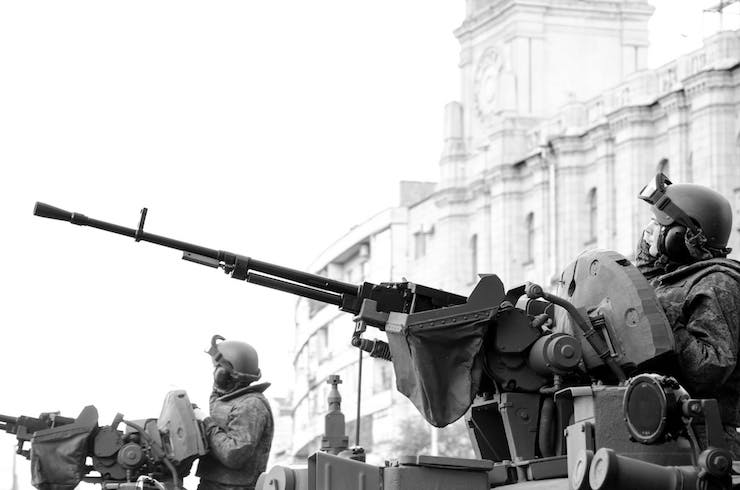Using Drones to Detect Unexploded Missiles in War Torn Areas

The news over the last few days have left many Americans fearing that we would be entering another time of war. Luckily the tensions seems to have subsided, for now. But in times of war there are certain things we hear of all the time like the use of military drones and missiles. In conflict torn regions the continuous launching of missiles becomes expected. Of all of these launched warheads only some of them explode when meeting their targets. Sometimes only 20% – 40% of launched missiles actually detonate, the rest being left behind intact yet still deadly. Eventually someone has to go and find these missiles that are often partially buried in the ground. This is a job that is not only dangerous and tedious, but somewhat like looking for a needle in a haystack.
These 3 meter long missiles are often launched from a truck bed and spread over a wide area as opposed to a designated target. As often found in conflict torn regions the areas under attack change from week to week and the region is often left with a debris field that can be quite vast. Many of the missiles being used are poorly made or come from stockade raids and can be up to 30 years old. These conditions lead to missiles that simply crash into the ground failing to explode upon impact.
A team of researchers from Binghamton University in New York has found a way of locating these hidden warheads so they can be safely removed from the environment. Led by Assistant Professor Alex Nikulin of the Geological Sciences and Environmental Studies department, they have begun using drones to efficiently locate buried warheads. The previous methods of sending people out into a field to manually search for missiles left behind works, but can take days to accomplish. Especially if the area of land being searched is also littered with other conflict debris. Using a drone the team led by Nikulin can cover these vast areas quickly. But right off the back he found a major problem with his project, all of the drones they were testing could only be airborne for a short period of time before their batteries would need to be switched or charged. “The big problem we ran into was when we started this was battery life,” says Nikulin. “We can’t use those drones for wide service areas.” They found themselves never really moving forward in their search of the landscape. Then Nikulin heard of a company from the Ukraine that had built a longer flying drone.
Based out of Kiev, UMT is a UAV company that specializes in building both long range and long endurance drones. UTM has two main platforms that they will customize to meet a client’s needs. The first drone they have is a tethered system called Cobra. As explained on their website, “The powerful Cobra tethered UAV is a multi-rotor observation and surveillance platform powered from the ground module via a specially-designed power cable. The tethered design allows this unique drone to stay in the air for days at a time.” Their other option is called Cicada and is described as “a copter equipped with a combustion engine and generator. Due to this feature, the copter is able to stay aloft much longer as compared to traditional electric drones powered by accumulator batteries. Cicada copter is able to take aboard useful load in amount of up to 3 kg; thereby, it can carry a fairly wide range of hardware.” Not only could this drone carry a 3kg load, but it could also stay in the air for up to 3 hours making it an ideal drone for Nikulin to use in his search for abandoned warheads.
So Nikulin contacted UMT and a collaboration was soon formed. Nikulin headed to the Ukraine to test UMT’s Cicada drone over an airfield suspected to be housing undetonated warheads. Suspended from the Cicada was a microfabricated magnetometer, a device that would scan the ground below to detect for conditions specific to 3 meter long warheads, weeding out any other metal debris in the area. Timothy de Smet, one of the researchers working with Nikulin, said “Everything that’s smaller than the object you’re looking for disappears. You’re using the altitude as a low-pass filter.” The team flew the drone over the airfield with the microfabricated magnetometer for about 45 minutes. When it was done they were able to go through the images collected, and as Nikulin said, “Our entire idea is you basically open up a laptop and in five minutes you have an actionable map.”
The map that they were able to compile with the drone blew everyone’s minds away. The data revealed a missile that the Ukrainian government was completely unaware of. The missile was almost fully buried vertically in the ground with just the tail end remaining above the soil surface. Accompanied by military personnel and a hand held GPS device the team was able to walk out to the site discovered by the drone. Sure enough, much to the surprise of the military representative, the missile was just where the map said it would be. Since this trial the program developed by Professor Nikulin has been granted International Mine Action Standards Certification to further carry out these research missions. But the research is about as far as Nikulin and his team can go. As Nikulin pointed out, “Then you as the stakeholder, the government regulator, the emergency ministry, the humanitarian organization, can use that data to plan your work.”
|